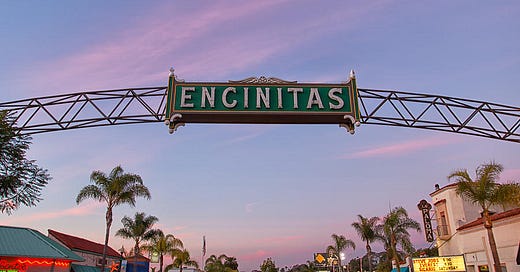Council Preview: June 4th-Homelessness in Encinitas: What’s Working and What Comes Next
In a special edition of our newsletter written by one of our community members, we are spotlighting the Homelessness Action Plan (HAP) which will be discussed at the City Council Meeting this week.
While Encintias4All strives to be a non-partisan reporter on Encinitas while asking some tough questions, we received this piece from a guest commentator and believe it deserves publication. The piece acknowledges concerns about rising homelessness and encourages the City Council to stay the course on solutions producing results. We hope you agree that it is valuable to publish this.
On Wednesday, June 4th, the Encinitas City Council will review its Homeless Action Plan (HAP). Adopted in early 2021, The HAP laid out a three-year road map for addressing the challenges of increasing homelessness in the City. Mayor Ehlers has declared homelessness as a top priority — as it should be. The number of people without homes in Encinitas has gone up in the last decade, according to the Point-in-Time Count (PITC), which tracks homelessness each year.
Some in the community are pushing for “tough love” ideas like cutting funding for services and shutting down the Community Resource Center (“CRC”) (notably a private non-profit which the City cannot simply shut down). Others, including Councilmembers O’Hara and Shaffer, want increased law enforcement. Public safety and quality of life matter to everyone in Encinitas. But if the City needs real impact on homelessness, that requires facts, not fear, and solutions that actually work.
Let’s start with some facts
Persons experiencing homelessness are not all drug users, criminals, or insane. According to the Regional Task Force on Homelessness (RTFH) and other local sources, the top 4 causes of homelessness are:
Expensive housing: Housing affordability is the #1 reported driver of homelessness in the county, and Encinitas is among the most expensive coastal cities in the region.
Job loss or insufficient income: Many people used to work but lost their jobs or don’t earn enough.
Mental health or addiction, often co-occurring
Family disruption or domestic violence, Domestic violence often forces women, kids, and LGBTQ+ youth out of their homes.
Homelessness cuts across all age demographics and includes veterans, women, families, and young adults. And people experiencing homelessness in Encinitas often grew up in Encinitas.
Many local organizations provide services to persons experiencing homelessness. Most notably, the Community Resource Center (CRC) has been here since 1979 and assists individuals and families facing domestic violence, hunger, and homelessness
Homelessness is not new but has grown in the last decade. The PITC chart from the City Staff report is telling. (One important point to add – the Regional Task Force on Homelessness (RTFH) leads the regional effort to conduct the PITC and provide the annual data to HUD).
Yet, there is hope… The Encinitas 2025 PITC showed year-over-year improvement.
So what’s working?
Encinitas HAP has 3 goals:
Goal 1: Increase the capacity of the City and the community to end homelessness in the City through the development of a collaborative community driven approach.
Goal 2: Decrease the number of individuals experiencing homelessness through a demand driven person-based homeless response and supportive housing services system.
Goal 3: Increase the availability of temporary and permanent housing.
The Encinitas HAP includes a variety of strategies to prevent and reduce homelessness in Encinitas…strategies which reflect national best practices and have been shown to functionally reduce homelessness. In poring over the City Staff report, here are some strategies that stand out.
These programs are still very new—some are only months old. But they’re already helping.
The Safe Parking Program helped 36 people in 2024. That’s 36 people who didn’t have to sleep on the street.
The Buena Creek Center helped 13 people move into permanent homes and others into temporary housing or hospitals.
The 2025 PITC shows 12.3% fewer unsheltered people than the year before.
What Should the Council Do Now?
Some Councilmembers want to increase law enforcement and reduce services. But that won’t solve the problem.
Laws are already enforced. Just giving tickets or moving people around doesn’t help them get off the streets—it doesn’t even move them somewhere else.
The best way forward is “compassionate accountability.” That means:
Offer real help like mental health care, job support, and housing.
Ask people to take steps forward, like working with service providers and making progress toward permanent housing.
Everyone cares about public safety and clean neighborhoods. But people want to treat others fairly and help them get back on their feet. Cities that focus only on punishment fail to reduce homelessness. Cities that combine help and responsibility see real progress.
Let’s Keep Doing What Works
The Council is doing the right thing by reviewing the Homeless Action Plan each year. That helps make sure the City improves as needed.
But cutting programs that are working, or relying mostly on police, won’t fix homelessness in Encinitas.
The Council needs to stay focused on real solutions in the next 3-year road map:
Hire expert staff and/or dedicated providers
Support local service groups like CRC
Help people find jobs, health care, support, and permanent housing
Create more affordable housing
Encinitas can be a city that leads with both compassion and results if it keeps doing the work that’s already showing progress—and give it the time needed to succeed.





Thank you for fact-based and compassionate reporting. They can go together!
This is an excellently written summary of the main elements required for an effective Homelessness Action Plan. This “proof of concept” (Redondo Beach) best practices to reach functional zero needs to be spread far and wide to Encinitas residents.